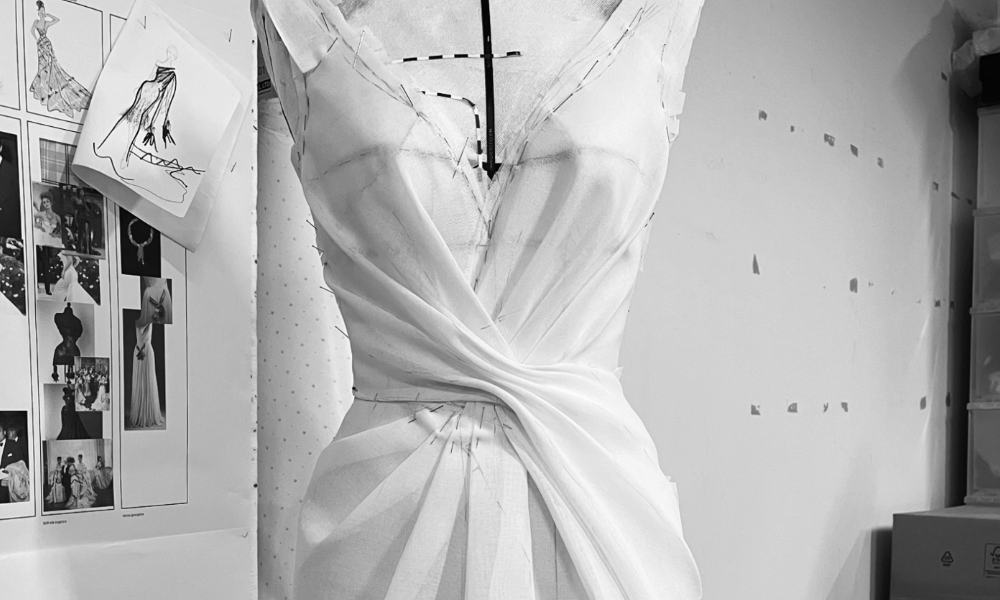Creative Pattern Cutting: The Dying Art

Why London fashion is in urgent need of Pattern Cutters who can drape.
There’s something happening in London studios right now. The industry is shrinking. Fashion brands are struggling to stay afloat. Over the decades I’ve worked in fashion, I’ve seen so many young and established designers fold. It seems to be the norm.
The one consistency is the foundation of the industry itself: its technical staff.
Working in this world for years, I’ve come to realise just how small it really is — how everyone has worked everywhere and knows one another. And in this evergreen, ever-precarious London luxury scene, we’ve hit a problem that’s not going to go away:
We’re running out of people who can drape — and who can execute creative pattern cutting at the highest level. Not because they don’t exist — but because they’re not being trained.
Pattern Cutting Has Become a Hotchpotch System in London
In London, fashion houses rarely grow to the scale of their French counterparts — aside from a few, like Burberry and McQueen. Studios are often built around a few trusted senior cutters, expected to deliver miracles on tight timelines. The pressure is on output — not growth. And that means training junior staff isn’t a luxury most teams can afford.
Even at top universities, the technical education is inconsistent at best. Courses are rich in concept and styling, but light on fit, form, and construction. Many students graduate having never draped / pattern cut a garment properly — or at all.
Why Paris Has the Advantage
In Paris, the grandes maisons — Dior, Chanel, Givenchy — still work the traditional way. They drape on the stand. They train from within. They’ve built teams with capacity — time, hierarchy, and deep respect for the cutter’s role.
London doesn’t have that kind of infrastructure. We run lean. Studios rely on overworked seniors churning out collections. There’s no time, no margin, and no one left to train the next generation.
The Role of the Draper Is Being Lost
Let’s be clear: draping isn’t some mystical, outdated method. It’s one of the most direct, intelligent, and responsive ways to work with fabric.
You see the shape before you cut. You resolve the design in real time in 3D. You feel the fabric, grain, the drop, the tension. You see proportions and volume. You make real decisions — not assumptions based on flat shapes.
But that kind of fluency only comes from practice. From mentorship. From being shown — not left to guess.
A Crisis That Affects the Whole Chain
What happens when we stop training cutters?
- Senior pattern cutters retire — taking decades of knowledge with them, unshared.
- Young designers launch brands with no one who can realise their ideas in 3D.
- Garment development gets slower, less accurate, more outsourced.
- We lose the embodied, tactile intelligence that great clothes rely on.
We lose creativity!
This isn’t about tradition. It’s about skill, clarity, and confidence.
Unless we act, that kind of creative precision is going to vanish from London’s fashion ecosystem completely.
Why I Built This Course
I never planned to teach. But after 15+ years in luxury fashion — often being the last line of defence in studio settings — I knew this couldn’t continue.
I have also reached a point of moving on with my ambitions with launching a brand of my own and taking a side step from the runways and clients. After so many years of feeling disheartened by the lack of creativity and design ability from the London scene. When, as a pattern cutter, you get asked to cut the same dress by different designers, you know there’s a problem.
So here I am… shouting about this to anyone who would listen.
I want to make the effort, to give back to the industry. I care too much about this craft to let it disappear. Not here in London. Not anywhere.
This course is for:
- The students who never got trained
- The cutters who want to step up
- The studios looking for someone who can “just fix it” — and actually knows how
Thank you for subscribing!
Have a great day!
Written by Arena Page

